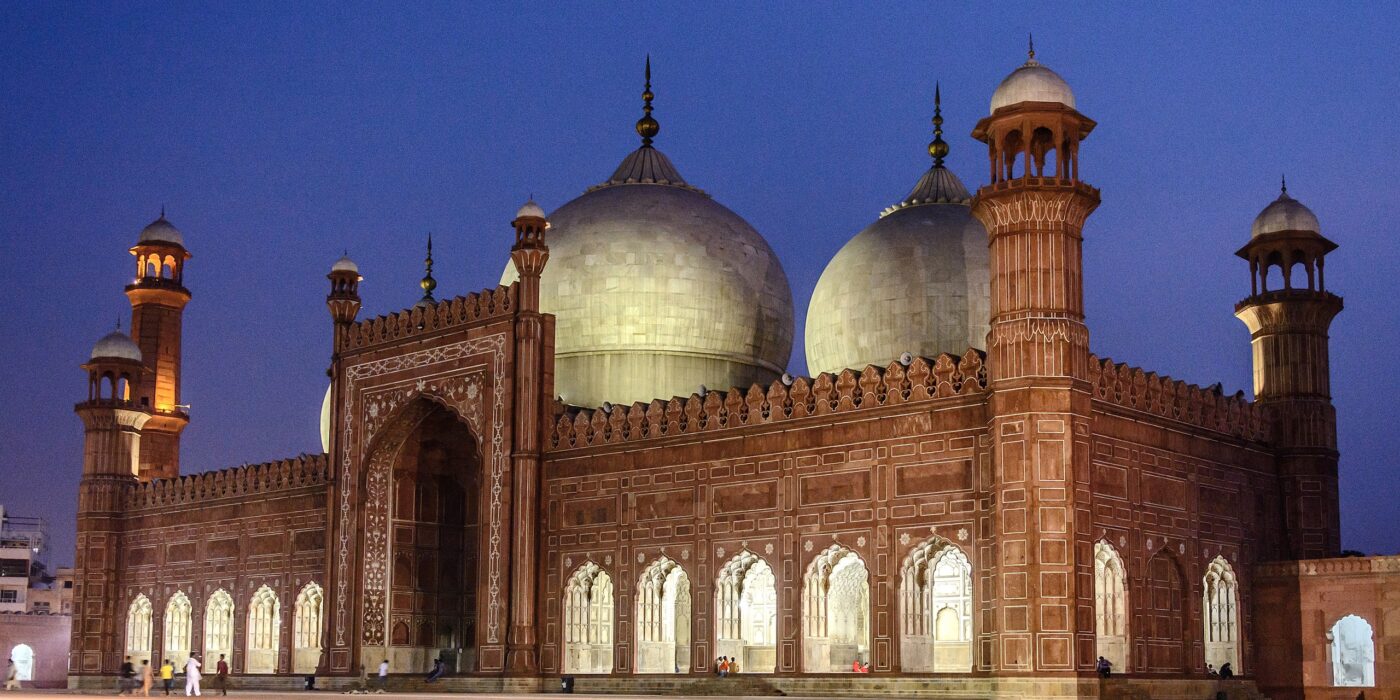Standing as a symbol of grandeur and Mughal legacy, the Badshahi Masjid in Lahore is one of the most iconic landmarks in Pakistan. Renowned for its majestic scale, intricate artistry, and historical significance, it draws visitors from around the world. Beyond its architectural beauty, the mosque represents centuries of cultural and religious heritage. In this guide, we delve deep and explore the historical, architectural, and touristic aspects of Badshahi Mosque, Lahore.
Key Facts | Badshahi Masjid
| Attribute | Details |
| Name | Badshahi Masjid |
| Location | Walled City of Lahore, Punjab, Pakistan |
| Commissioned By | Mughal Emperor Aurangzeb Alamgir |
| Construction Period | 1671 – 1673 |
| Architect / Supervisor | Muzaffar Hussain (Fidai Khan Koka) |
| Materials Used | Red sandstone and white marble |
| Prayer Hall Capacity | ~10,000 inside; ~100,000 in courtyard |
| Courtyard Area | 276,000 sq. ft |
| Minarets | Four large minarets (226 ft) + four smaller corner minarets |
| Domes | Three large domes (central dome largest) |
| UNESCO Tentative Listing | Added in 1993 |
| Adjacent Attractions | Lahore Fort, Alamgiri Gate, Hazuri Bagh, Fort Road Food Street |
Badshahi Masjid History
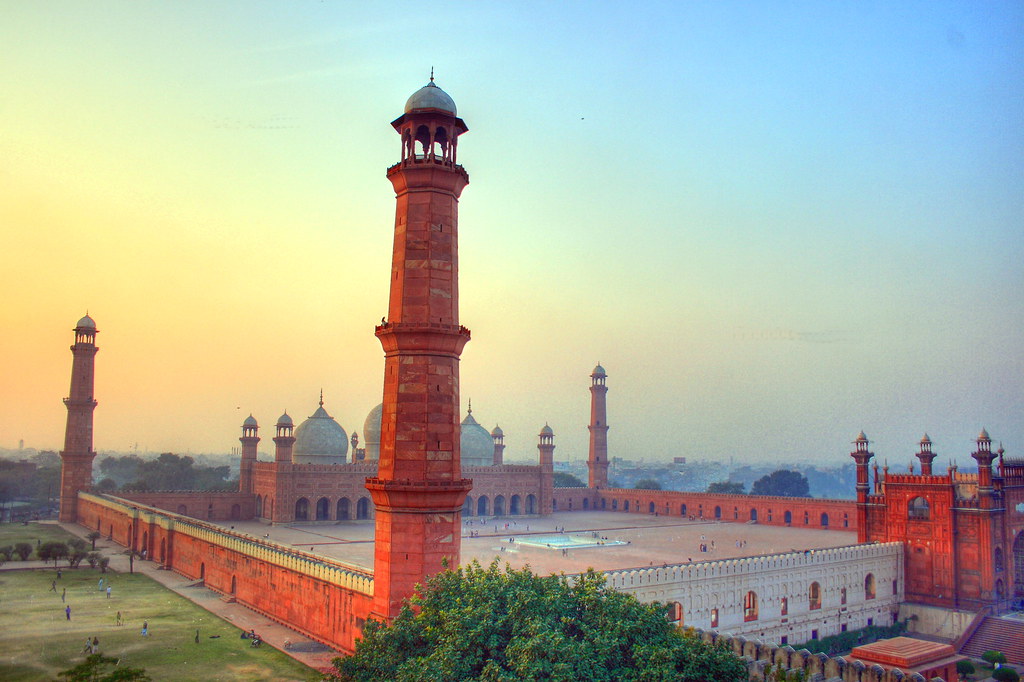
The Badshahi masjid, also known as the “Emperor’s Mosque,” is one of the most iconic landmarks of Lahore and a testament to Mughal architectural grandeur.
Commissioned by Emperor Aurangzeb Alamgir in 1671 and completed in 1673, it was designed to symbolize Mughal power and celebrate Aurangzeb’s military victories.
Mughal Era (1671–1707)
- Built to commemorate military campaigns, particularly against the Marathas.
- Strategically located adjacent to Lahore Fort, reflecting Mughal emphasis on grandeur and symmetry.
- Construction supervision: Overseen by Muzaffar Hussain (Fidai Khan Koka), Aurangzeb’s foster brother and Lahore’s governor.
- Designed with massive scale and intricate ornamentation, including marble inlay and calligraphy.
Sikh Era (1799–1849)
- The Badshahi Masjid was repurposed as a military garrison.
- Courtyard used as stables; surrounding chambers served as barracks.
- Maintained structural integrity but lost much of its religious function during this period.
British Era (1849–1947)
- Continued military use under British rule.
- Restoration efforts began in 1852 to protect architectural features.
- Gradually returned to the Muslim community for worship, balancing preservation with functional use.
Post-Independence Pakistan (1947–Present)
- Extensive conservation and restoration projects undertaken:
- Repairs to red sandstone and white marble façades.
- Restoration of intricate calligraphy and decorative motifs.
- Maintenance of the Badshahi Masjid’s vast courtyard, capable of holding over 100,000 worshippers.
- Today, the mosque serves both as a place of worship and a major cultural and tourist attraction.
Architecture and Design of Badshahi Masjid
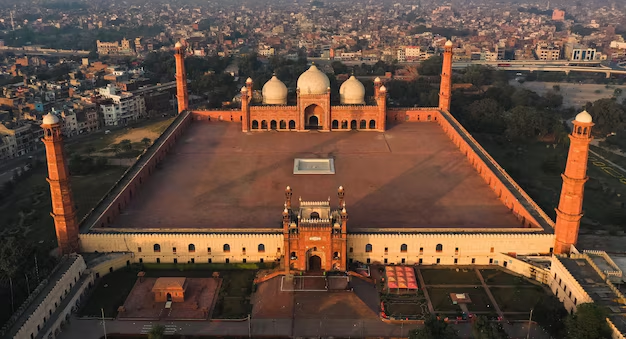
The Badshahi Masjid stands as a testament to the pinnacle of Mughal architectural mastery, showcasing symmetry, grandeur, and meticulous artistry.
Its design was carefully planned to reflect imperial authority while providing a functional space for thousands of worshippers.
Mughal Construction Emblem
The badshahi masjid lahore embodies classic Mughal architectural principles, emphasizing balance, proportion, and intricate decorative work.
Its layout reflects perfect symmetry, and every element, from arches to domes, was designed to convey magnificence and spiritual serenity.
Materials Used
Constructed primarily from red sandstone with white marble inlays, the mosque combines durability with aesthetic appeal. The materials were chosen not only for their strength but also to highlight ornamental features and calligraphy across the complex.
Prayer Hall
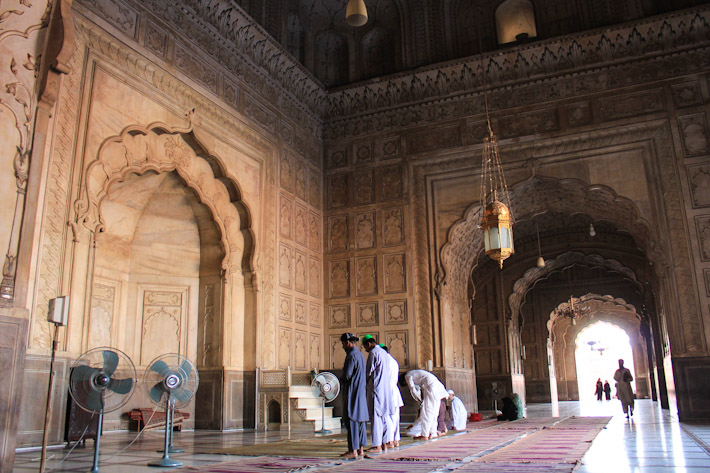
The prayer hall is the heart of the mosque, accommodating thousands of worshippers. It is adorned with:
- Floral motifs carved in marble and plaster
- Islamic calligraphy featuring Quranic inscriptions
- Geometric patterns reflecting Mughal artistry
The design allows ample natural light and ventilation, creating a serene environment for prayer.
Domes and Minarets
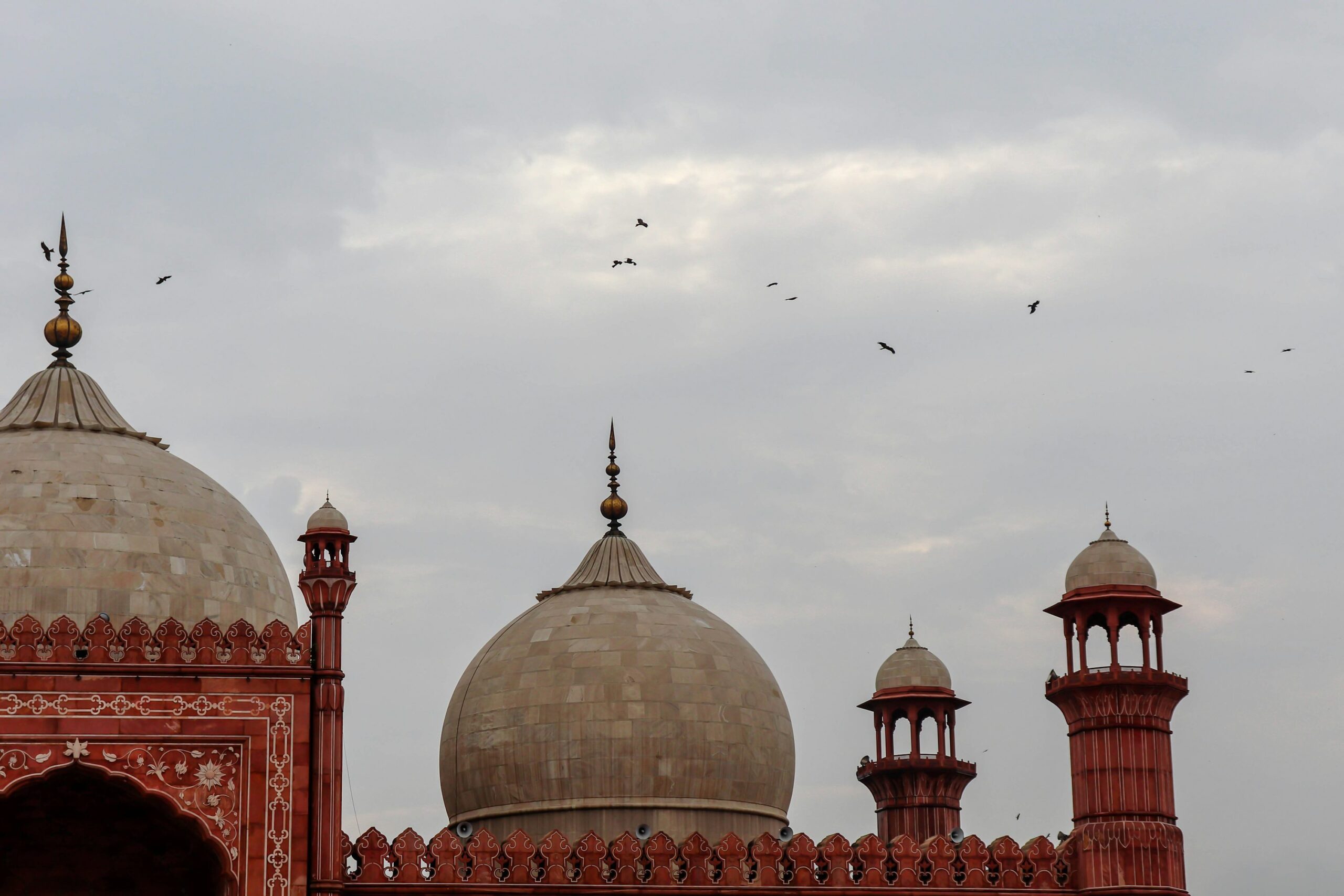
Crowning the mosque are three large domes, with the central dome being the tallest. At each corner rise four towering minarets, approximately 226 feet (69 meters) high.
These minarets enhance the mosque’s vertical grandeur while serving traditional functional purposes such as the call to prayer.
Courtyard
The mosque’s expansive courtyard can accommodate up to 100,000 worshippers, making it ideal for Eid congregations and Friday prayers.
It is surrounded by arcades and perimeter walls adorned with decorative motifs, emphasizing the scale and majesty of the complex.
Adjacent Structures
- Alamgiri Gate: a grand entrance that complements the mosque’s architectural splendor.
- Perimeter walls and surrounding arcades: feature intricate designs, maintaining visual harmony with the main mosque.
Tourism and Visitor Information
The Badshahi Mosque is situated in the heart of Lahore’s Walled City, directly adjacent to the historic Lahore Fort. Its central location makes it a must-visit landmark for tourists exploring the city’s rich cultural heritage.
For photography enthusiasts, the best times to visit are early morning and during sunset, when natural lighting highlights the mosque’s red sandstone and marble façade, offering breathtaking views.
Nearby Attractions

- Hazuri Bagh: a beautifully manicured garden located between the mosque and the fort.
- Fort Road Food Street: offers local cuisine with a panoramic view of the mosque.
- Lahore Fort: another UNESCO World Heritage Site, showcasing Mughal architecture.
Accessibility and Entry Tips
- Easily accessible via public transport or private vehicles.
- Entry is generally free, but visitors are expected to observe mosque etiquette (modest dress, removal of shoes).
- Guided tours are available to provide historical and architectural insights.
The Badshahi Mosque plays a vital role in cultural heritage tourism, attracting thousands of local and international visitors annually. Its grandeur and historical significance make it a key destination for anyone exploring Mughal-era architecture in Pakistan.
Mughal Construction Legacy
The Badshahi Mosque represents the last major mosque constructed during the Mughal era in the Indian subcontinent, reflecting the empire’s architectural zenith.
Its design emphasizes grand scale, meticulous precision, and elaborate decorative elements, characteristics typical of late Mughal architecture.
Architectural Influence
- The mosque has inspired later mosque designs across South Asia, particularly in Pakistan and northern India.
- Its courtyard layout, towering minarets, and central dome became a reference point for subsequent religious structures.
Mughal Innovations
- Courtyard Planning: designed to accommodate tens of thousands of worshippers while maintaining symmetry and accessibility.
- Minaret Height and Placement: strategically positioned for aesthetic balance and functional use.
- Dome Engineering: large central dome flanked by smaller domes, showcasing advanced Mughal construction techniques.
Through its architectural innovations and artistic mastery, the Badshahi Mosque remains a symbol of Mughal ingenuity, combining functionality, aesthetics, and imperial authority in one monumental structure.
Comparison with Other Mughal Mosques
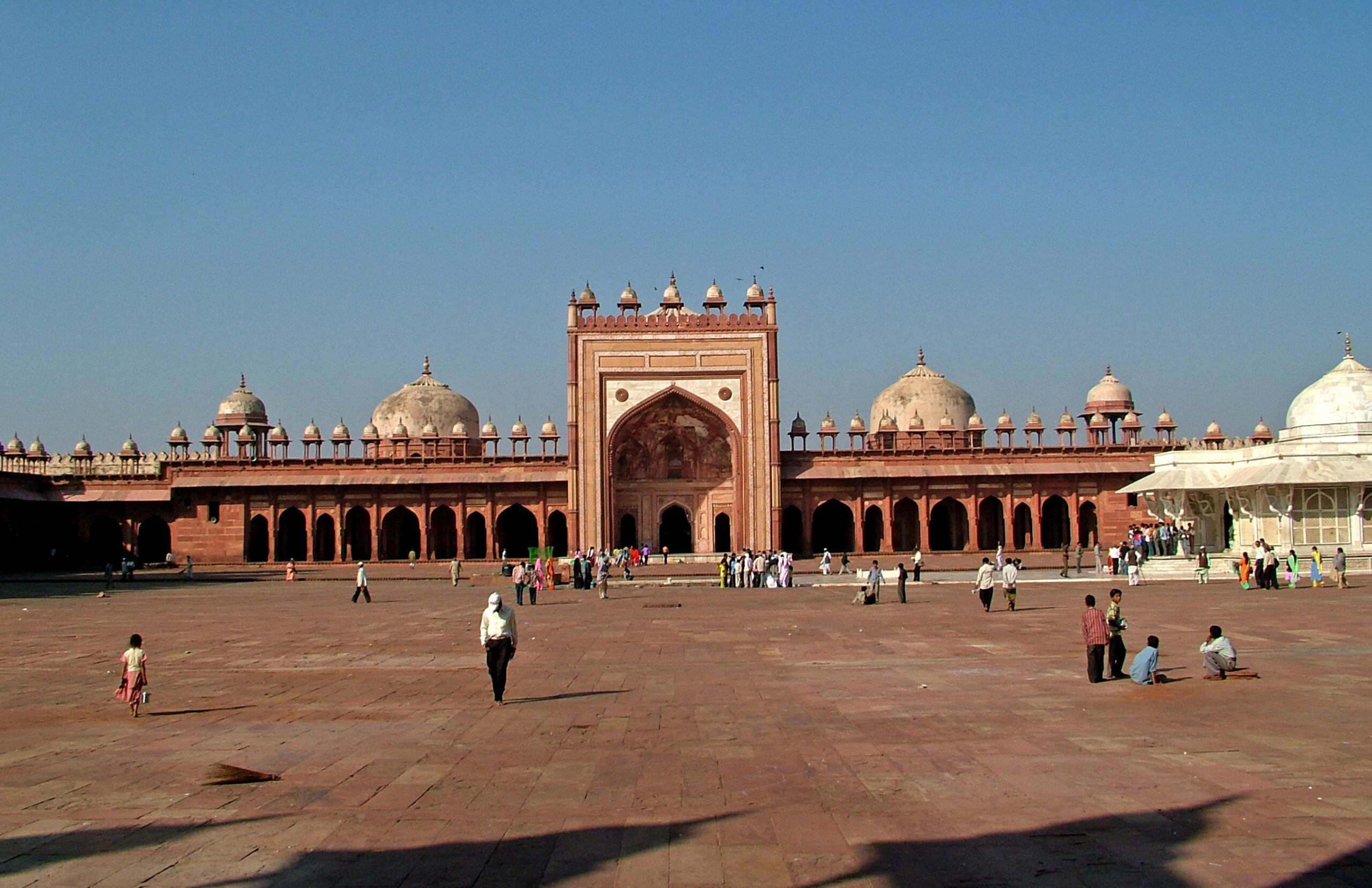
The Badshahi Mosque is often compared with other iconic Mughal-era mosques, such as Jama Masjid in Delhi, Fatehpur Sikri Mosque, and Wazir Khan Mosque in Lahore, highlighting both similarities and unique features.
Similarities:
- Materials: Like many Mughal mosques, Badshahi Mosque uses red sandstone with white marble inlays, reflecting the Mughal preference for contrast and elegance.
- Symmetry and Design: Mughal architecture emphasizes perfect proportionality, and all these mosques demonstrate meticulous planning in layout, dome placement, and minaret alignment.
- Courtyard Size: Expansive courtyards are a hallmark of Mughal mosques, designed to accommodate thousands of worshippers during congregational prayers.
Unique Features of Badshahi Mosque:
- Scale: Badshahi Mosque has one of the largest courtyards in the world, accommodating up to 100,000 worshippers, surpassing most other contemporary Mughal mosques.
- Dome and Minaret Design: The mosque boasts three massive domes, with the central dome being the largest, flanked by four corner minarets that rise 226 feet high, creating a striking skyline.
- Decorative Excellence: Its intricate marble inlay, floral motifs, and calligraphy are more extensive and elaborate than many other Mughal mosques.
- Cultural Significance: Badshahi Mosque serves as a cultural emblem of Lahore which itself is the cultural hub, representing Mughal grandeur at its zenith.
Through these unique features, the Badshahi Mosque stands not just as a place of worship but also as a symbol of Mughal architectural mastery and innovation in the Indian subcontinent.
Conservation Efforts and UNESCO Status
The Badshahi Mosque is not only an architectural landmark but also a cultural heritage site requiring ongoing preservation.
UNESCO Recognition:
- In 1993, the mosque was added to Pakistan’s Tentative List for UNESCO World Heritage Site consideration, highlighting its global cultural and historical significance.
Conservation and Maintenance Programs:
- Structural Preservation: Restoration works focus on maintaining the integrity of minarets, domes, and perimeter walls, ensuring they withstand environmental stress and aging.
- Artistic Preservation: Efforts are made to conserve intricate marble inlays, calligraphy, and floral motifs, which are essential to the mosque’s Mughal identity.
- Public Engagement: Punjab Tourism and heritage authorities coordinate with cultural organizations to provide guided tours, educational programs, and visitor facilities, promoting awareness of its historical importance.
- Regular Maintenance: Continuous upkeep includes cleaning, repairs, and structural assessments to preserve both aesthetic beauty and functional safety for worshippers and tourists.
These efforts ensure that the Badshahi Mosque Lahore remains a living monument, retaining its splendor for future generations while accommodating thousands of visitors annually.
FAQs
- When was the Badshahi Mosque built?
It was commissioned in 1671 by Emperor Aurangzeb and completed in 1673, during the height of the Mughal Empire. - Who commissioned and supervised its construction?
Aurangzeb Alamgir commissioned the mosque, and construction was overseen by Muzaffar Hussain (Fidai Khan Koka), Aurangzeb’s foster brother and governor of Lahore. - What materials were used in its construction?
The mosque was built with red sandstone and white marble, with elaborate marble inlays, calligraphy, and decorative motifs adorning both interior and exterior surfaces. - How many worshippers can it accommodate?
The prayer hall and vast courtyard together accommodate over 100,000 worshippers, making it one of the largest mosque complexes globally. - What are the visiting hours and entry requirements?
Visitors can enter daily, with modest attire and shoe removal required. Guided tours are available to provide historical and architectural insights. - Why is it considered a Mughal architectural masterpiece?
The mosque exemplifies grand scale, perfect symmetry, and intricate artistry, combining engineering ingenuity with aesthetic excellence characteristic of late Mughal architecture. - Who built Badshahi Masjid?
Badshahi Masjid built by Mughal Emperor Aurangzeb Alamgir in 1673.
For more information on similar blogs like Deforestation in Pakistan, visit Chakor blogs.

